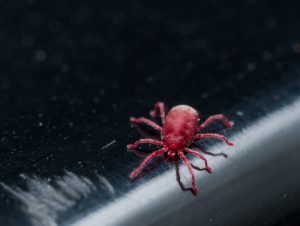Clover Mites Are Common in Lush Lawns
By Chris Williams on April 4, 2012.
Q. We live in a new home. Last summer we had a terrible problem with clover mites getting into our home and I’m starting to notice some again this year. Is there anything we can do besides just vacuuming them up once they’re inside?
A. As you know, clover mites are outdoor lawn pests that occasionally find their way indoors. They are usually first noticed on the outside walls of a building or inside around windowsills and doors. Since clover mites are only about the size of a period at the end of a sentence, they can squeeze through screens or any tiny opening and end up inside. They’re big enough to be seen (just barely) when large numbers are clumped together on a light surface.
 Rest assured that the clover mites’ red color is not from feeding on human blood. They feed outside on grasses, clover, and other plants, not on people. Clover mites won’t damage indoor plants and they won’t live long in the drier indoor conditions.
Rest assured that the clover mites’ red color is not from feeding on human blood. They feed outside on grasses, clover, and other plants, not on people. Clover mites won’t damage indoor plants and they won’t live long in the drier indoor conditions.
Clover mites often migrate in spring or fall, during droughts, or when outside populations get too large – which often happens in new lawns or in lawns that have been heavily fertilized. They are attracted to warm, light-colored surfaces on exterior walls, windows, and doors. A typical place to find clover mites is in a warm, sunny spot on white exterior siding, on the south-facing side of a new home that has a new, lush lawn. That probably pretty accurately describes your situation.
Clover mites can build up to high numbers in new developments where scraped, bare soil has been seeded for grass. After the lawns become well established, clover mite problems usually subside. In your case, this year’s infestation shouldn’t be as bad as last year’s. In the meantime, there are steps you can take to reduce clover mite problems:
- Leave an 18 to 24 inch wide grass and shrub-free barrier strip along foundation walls. The strip can be ornamental gravel, bark mulch, bare soil, or can be planted in flowers that clover mites do not like such as geranium, zinnia, marigold, salvia, rose, chrysanthemum, or petunia.
- Mow your lawn short and reduce the amount of fertilizer used on the lawn. Prune back any shrubs that are touching the house and remove any ivy growing on exterior walls.
- Indoors, vacuum up clover mites using a soft brush tool that won’t crush them; they can leave a red stain on surfaces. Dispose of the vacuum bag afterwards in a sealed plastic bag. Avoid sweeping or brushing the mites.
- Contact a pest control company, like Colonial, to do a perimeter treatment around your home’s foundation to keep mites from climbing outside walls.